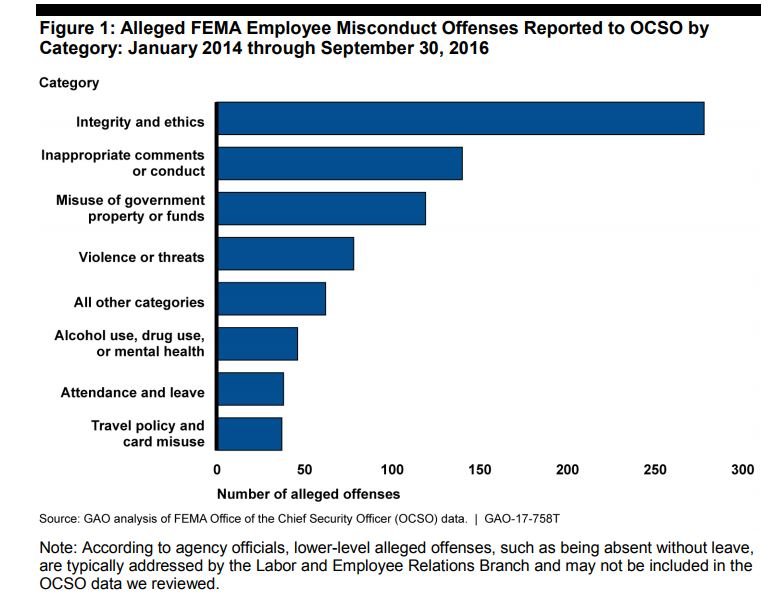

FEMA has a limited view into the allegations of misconduct that come from the agency's employees, because it lacks both the case management system and the written...
The Federal Emergency Management Agency has a limited view into the allegations of misconduct that come from the agency’s employees.
That’s in part FEMA’s own doing, because it lacks both the case management system and the written disciplinary policies to address misconduct from its cohort of temporary employees. But it’s also a broader challenge; as FEMA and other agencies hire, fire and discipline temporary employees under a different set of standards than most full-time federal workers.
FEMA’s Office of the Chief Security Officer collected 595 complaints with 799 possible offenses from January 2014 through September 2016, according to the Government Accountability Office.
Both members of the House Homeland Security Oversight and Management Efficiency Subcommittee and FEMA leadership say the number of complaints represents a relatively small fraction of the agency’s workforce.
But misconduct was most common among FEMA’s part-time reservists, GAO found.
“Agencies send a clear message when they have strong processes, controls and systems to handle them quickly and effectively,” Chris Currie, director of homeland security and justice issues for GAO, told the subcommittee during a July 27 hearing.
But FEMA doesn’t have clear policies and procedures for all employees.
Of FEMA’s workforce of 22,000 workers, the agency hires about 7,000 of them as temporary employees. Many are “on loan” from other DHS components and agencies who work for the agency during natural disasters or during other periods of “surge” work.
The agency doesn’t have a written disciplinary process or appeals procedure for these reservist employees or its surge capacity workforce. But if FEMA did have a written policy, it would significantly differ from the procedures for full-time employees at the agency and throughout the federal workforce.
First, FEMA lacks the authority to take disciplinary action against some its temporary employees, because members of the Surge Capacity Force remain employed at their “home” agency and work for FEMA on a temporary basis.
In addition, FEMA’s Surge Capacity Force and reservist workers are not hired under Title 5, unlike many of the agency’s full-time employees. Title 5 employees are hired and fired under a specific set of merit system principles, and they have certain due process rights to appeal or challenge a disciplinary action.
The employees that make up FEMA’s temporary workforce, however, are considered “at-will” workers, meaning their supervisors can remove or demote them without notice or right to appeal for “good cause, bad cause or no cause at.”
Of the 595 complaints GAO reviewed during its three-year study, grievances related to employee integrity and ethics were the most common type of offense.
“It’s important that there’s a system in place for these instances, because even though they’re volunteers — and we appreciate their service in taking time away from what they do — they are representing FEMA at a critical time, when all eyes are on FEMA,” Rep. Scott Perry (R-Pa.), chairman of the House Homeland Security Oversight and Management Efficiency Subcommittee, said. “We must be ensured of their integrity and their work ethic and everything that goes with that.”

FEMA also lacks a single case management system to track misconduct allegations and investigations, Currie said.
The agency tracks misconduct allegations from three different agency systems at three different offices: the Office of the Chief Component Human Capital Officer Labor and Employee Relations Branch, the Office of the Chief Counsel Personnel Law Branch and the Office of the Chief Security Officer, where GAO collected its data.
Each office maintains information about these cases in different formats and systems, making it difficult for FEMA leadership to track investigations and look for trends.
David Grant, the agency’s acting deputy administrator, said FEMA is working with the Homeland Security Department’s Office of the Inspector General to adopt the IG’s case management system. It’s testing the IG’s case management system through October. If the agency decides that the IG system can operate on its network, FEMA will deploy it first at the Office of the Chief Security Officer as a pilot.
“If that then works, then we will deploy it across our enterprise and it will become a singular system with common nomenclature [and] common case management numbers,” Grant said.
Eventually, FEMA hopes the new system will allow the agency to track misconduct cases from start to finish.
Clearer policies and a single case management system will help, but the American Federation of Government Employees, which represents some FEMA employees, is calling for a broader solution.
“If this subcommittee is truly interested in providing the public with well-trained, qualified and accountable emergency workers, then the current practice of hiring reservists and [Surge Capacity Force volunteers] ‘at will’ should end,” Jacqueline Simon, AFGE director of policy, said in her written testimony. “Rather the entire emergency workforce at FEMA should be hired under Title 5 authorities. This will ensure they are properly vetted, trained and disciplined and protect the public from potential financial or political corruption.”
Hiring all FEMA employees under Title 5 would encourage both temporary and full-time workers to report instances of misconduct, waste, fraud and abuse, and it would prompt the agency to hold all employees accountable for wrongdoing, AFGE argued.
It could also have an impact on the agency’s morale, which has typically been low in recent years.
“You cannot separate the morale of the employees from the mission of the organization,” Currie said. “Those two are tied together. They’re not separate things.”
FEMA is updating its human capital procedures for reservists and the Surge Capacity Force, which should be finalized by Dec. 31, Grant said.
Copyright © 2024 Federal News Network. All rights reserved. This website is not intended for users located within the European Economic Area.
Nicole Ogrysko is a reporter for Federal News Network focusing on the federal workforce and federal pay and benefits.
Follow @nogryskoWFED

